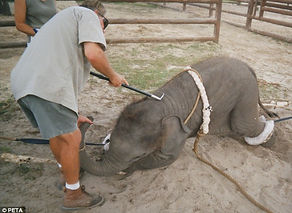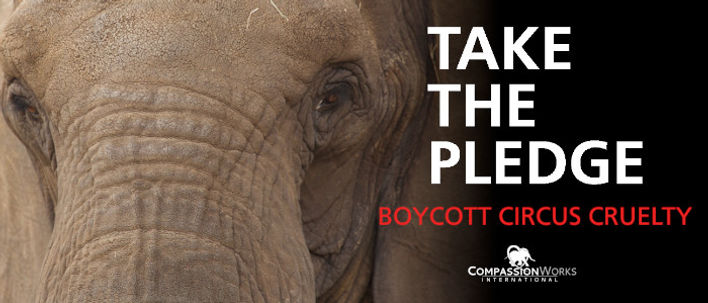
Circuses abuse animals to force them to perform stupid tricks.
Facts:
Growing up, many of us were excited to go to the circus. And why wouldn't we be? Images of circus life often surround us when we are children. Clowns, big tops, and circus acts are common themes for our birthday parties, or at our amuseument parks, or in our movies. We take for granted the iconic image of a ringmaster holding a whip in the center of a ring. But let's pause for a moment and look again...what's that guy doing with a whip?
The circus has lied to us from the time we were small, making us think that whipping tigers or making elephants stand on their heads is "normal," when those activities are anything but normal. They are examples of animal abuse and the only true reason it happens is to line the pocketbooks of the businesses that hold the animals captive, depriving them of their homes, their families, and their freedom.
In the hands of their “trainers”, animals confined to the circus endure repeated
and prolonged suffering from the time they are babies. This suffering was
revealed to the world in 2009, when whistleblower Sam Haddock shared photos
of baby elephant training with the world. The photos revealed that babies are
separated from their mothers, tied with ropes by all of their limbs and by
their tiny trunks, and forced into performing unnatural postures using sharp
metal weapons called "bullhooks" .
This treatment continues throughout their lives. At any circus performance featuring
elephants, you will see a trainer or several trainers with bullhooks in hand. The elephants know that bullhooks are weapons that will hurt them if they do not do as their handlers request.
Tigers are also subjected to injurious forms of training. Whips, tight collars, and electric prods are used to force the animals into doing unnatural postures like standing on their hind legs or performing synchronized movements.
Unlike the training of our dogs or cats, the training of wild animals involves abuse. They do not respond to "positive reinforcement" techniques. Do not believe circus lies. Circus training IS animal abuse.
Training is not the only form of abuse the animals in the circus endure.
In the wild, elephants and tigers will walk and run miles each day. Yet in the circus the animals are confined to small cages, or chained, and are unable to move about as they would naturally. The animals are also frequently transported in train cars or in trucks, and kept there for numerous hours or even days at a time. Some animals are forced to travel up to 90% of their lives.
When you visit an elephant in a circus or zoo, look for them slowly swaying their heads back and forth or rocking from side to side. These actions are called "stereotypic" behaviors and they indicate psychological distress. The intensive confinement of elephants coupled with a lack of ability to socialize with their families, or even others of their kind, causes them to experience emotional trauma. What would your experience of life be like if you were torn from your family and confined in a jail cell?
Elephants, tigers, and other animals used by the circus are sentient beings, just like you. They have thoughts, feelings, and a desire to be free. Boycott events that cause suffering to animals.


Take Action
We encourage the use of peaceful, educational, lawful demonstration as a primary means for getting the word out about circus cruelty. We feel so strongly about this that we have dedicated an entire website to helping you mount successful circus protests!
Click the link below to learn how to protest, gather the materials you need to protest, and to find out if any protests are taking place in your area.

Other Actions
1. Create a ban on the use of wild animals in entertainment in your town, city, county, or state. Contact us for more information.
2. Share information on circus cruelty within your social networks. Our videos are a great way to do that!
3. Perform a circus investigation for CWI. Contact us to get involved. Learn the fundamentals on how to effectively video an animal cruelty event here.
4. Sign petitions for our current campaigns.
5. Write a letter to the editor when the circus heads to your area. Contact us if you need assistance.
7. Wear a t-shirt that shares an anti-circus message. View our selection in our store.
8. Make a donation to support our work, and help us to continue to assist activists across the world combat circus cruelty in their communities.

